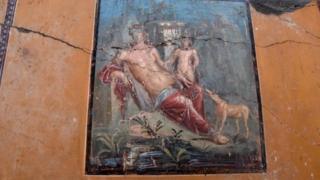 Image copyright
Image copyright
EPA
The fresco is in a room found to be littered with artwork and designs
Archaeologists in Pompeii have announced their latest find on Valentine’s Day – a fresco of Narcissus, who loved only himself.
Pompeii, an ancient Roman city in Italy, was buried under volcanic ash when Mount Vesuvius erupted in 79 AD.
The fatal eruption froze the city and its residents in time, making it a treasure trove for archaeologists.
The latest artwork was discovered in the same house where another fresco was uncovered late last year.
The director of the site, Alfonsina Russo, said the “beauty of the rooms” in that discovery had made officials change their plans and search further.
She said it was hoped the house, a wealthy residence near Pompeii’s centre, might eventually open to the public.
- Victim crushed by boulder is uncovered
- Pompeii’s not-so-ancient Roman remains
- Horse found in harness in Pompeii
A press release from archaeologists described the fresco’s surroundings as an “elegant and sensual” bedroom.
They said its ceiling had collapsed, but excavators were able to uncover the design of the fresco and find fragments to piece it together.
Image copyright
EPA
Images of the heavily decorated bedroom have been released to the public
“The extraordinary discoveries of this site continue,” general director Massimo Osanna said in a statement.
“This decoration was intentionally luxurious, and probably dated to the last years of the colony, as indicated by the extraordinary preservation state of the colours,” he added.
Who was Narcissus?
In Greek mythology, Narcissus was a hunter – born from the river god Cephissus and a nymph named Liriope.
He was said to be impossibly handsome, but did not pursue any love interest presented to him – leaving behind a trail of devastated suitors.
Image copyright
Getty Images
Seeing your own reflection was shrouded in superstition in Greek mythology
One was said to have been a nymph named Echo who after being harshly rejected, was left in heartbroken despair. Afterwards she paced alone around nature for the rest of her life, gradually fading to an echo.
As punishment, a deity of revenge was then said to have led Narcissus to a pool of water where he found his own reflection.
He is said to have become so enamoured with himself that he stared at his own appearance until he died.
The mythological figure was very popular within Roman art.
He is also where the term narcissism comes from – meaning an excessive interest in oneself.
It was first popularised as a psychological term by Sigmund Freud in the 20th Century.
Pompeii: Narcissus fresco uncovered by archaeologists

